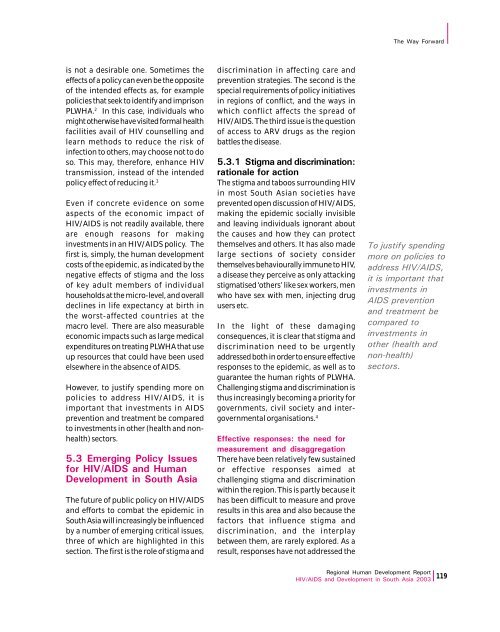Download Report - UNDP Asia-Pacific Regional Centre - United ...
Download Report - UNDP Asia-Pacific Regional Centre - United ...
Download Report - UNDP Asia-Pacific Regional Centre - United ...
Create successful ePaper yourself
Turn your PDF publications into a flip-book with our unique Google optimized e-Paper software.
The Way orwardis not a desirable one. Sometimes theeffects of a policy can even be the oppositeof the intended effects as, for examplepolicies that seek to identify and imprisonPLWHA. 2 In this case, individuals whomight otherwise have visited formal healthfacilities avail of HIV counselling andlearn methods to reduce the risk ofinfection to others, may choose not to doso. This may, therefore, enhance HIVtransmission, instead of the intendedpolicy effect of reducing it. 3Even if concrete evidence on someaspects of the economic impact ofHIV/AIDS is not readily available, thereare enough reasons for makinginvestments in an HIV/AIDS policy. Thefirst is, simply, the human developmentcosts of the epidemic, as indicated by thenegative effects of stigma and the lossof key adult members of individualhouseholds at the micro-level, and overalldeclines in life expectancy at birth inthe worst-affected countries at themacro level. There are also measurableeconomic impacts such as large medicalexpenditures on treating PLWHA that useup resources that could have been usedelsewhere in the absence of AIDS.However, to justify spending more onpolicies to address HIV/AIDS, it isimportant that investments in AIDSprevention and treatment be comparedto investments in other (health and nonhealth)sectors.5.3 Emerging Policy Issuesfor HIV/AIDS and HumanDevelopment in South <strong>Asia</strong>The future of public policy on HIV/AIDSand efforts to combat the epidemic inSouth <strong>Asia</strong> will increasingly be influencedby a number of emerging critical issues,three of which are highlighted in thissection. The first is the role of stigma anddiscrimination in affecting care andprevention strategies. The second is thespecial requirements of policy initiativesin regions of conflict, and the ways inwhich conflict affects the spread ofHIV/AIDS. The third issue is the questionof access to ARV drugs as the regionbattles the disease.5.3.1 Stigma and discrimination:rationale for actionThe stigma and taboos surrounding HIVin most South <strong>Asia</strong>n societies haveprevented open discussion of HIV/AIDS,making the epidemic socially invisibleand leaving individuals ignorant aboutthe causes and how they can protectthemselves and others. It has also madelarge sections of society considerthemselves behaviourally immune to HIV,a disease they perceive as only attackingstigmatised ‘others’ like sex workers, menwho have sex with men, injecting drugusers etc.In the light of these damagingconsequences, it is clear that stigma anddiscrimination need to be urgentlyaddressed both in order to ensure effectiveresponses to the epidemic, as well as toguarantee the human rights of PLWHA.Challenging stigma and discrimination isthus increasingly becoming a priority forgovernments, civil society and intergovernmentalorganisations. 4Effective responses: the need formeasurement and disaggregationThere have been relatively few sustainedor effective responses aimed atchallenging stigma and discriminationwithin the region. This is partly because ithas been difficult to measure and proveresults in this area and also because thefactors that influence stigma anddiscrimination, and the interplaybetween them, are rarely explored. As aresult, responses have not addressed theTo justify spendingmore on policies toaddress HIV/AIDS,it is important thatinvestments inAIDS preventionand treatment becompared toinvestments inother (health andnon-health)sectors.<strong>Regional</strong> Human Development <strong>Report</strong>HIV/AIDS and Development in South <strong>Asia</strong> 2003 119
















